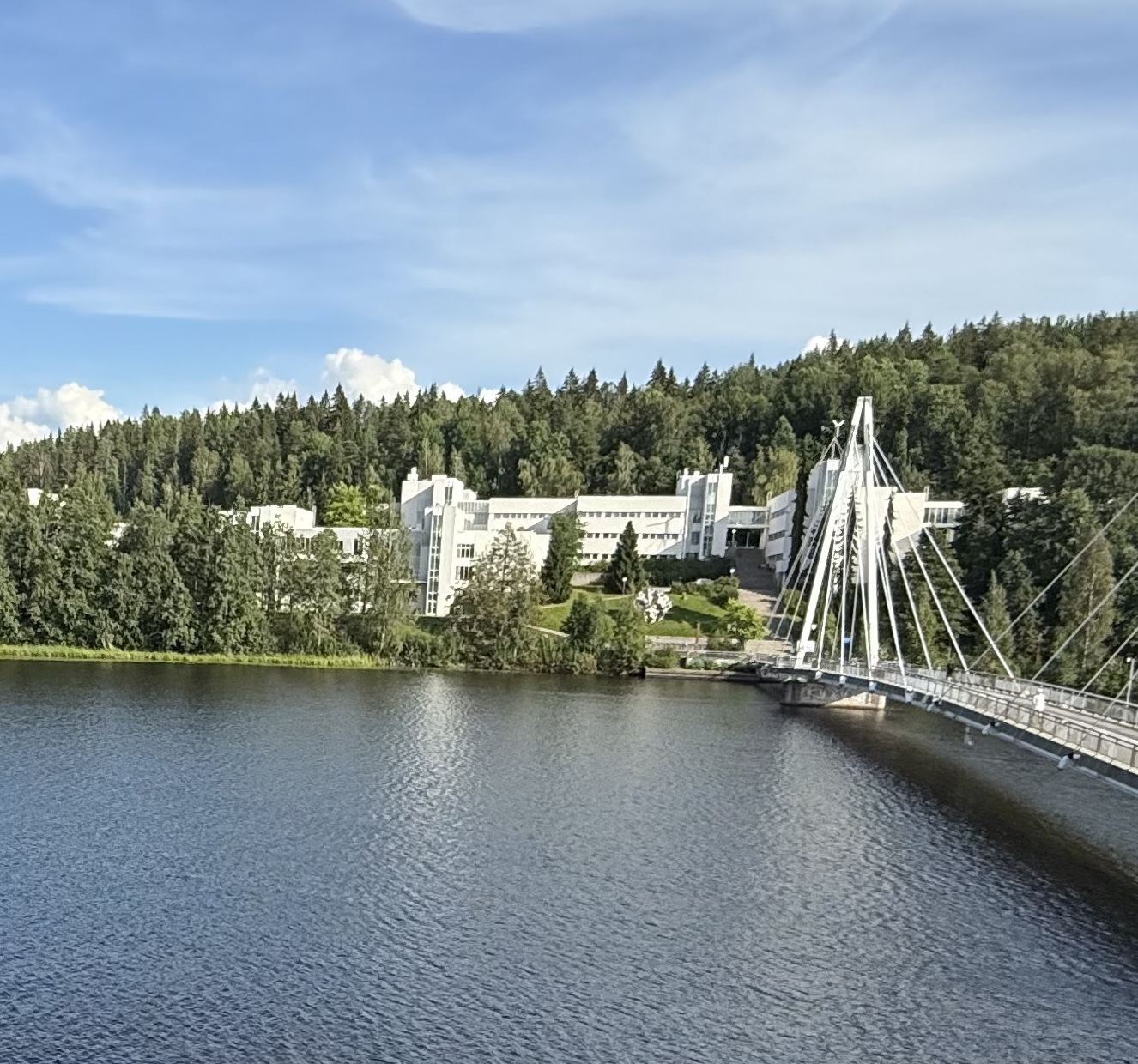Jyväskylä Summer School 2025

I am teaching the summer school course Random Geometry and Embeddability (MA3) at the 34$^{th}$ Jyväskylä summer school course. Here you can (eventually) find extra information on the course such as exercises, resources, and handwritten notes.
Exercises
To get credit on MA3, please hand in solutions to the exercises below (at least 10, four of which marked by * that are not related) either in person, or scanned, by 15 August to [email protected].
Lecture 1
- Let $M_k^n$ be the set of all $n$-angulations of the sphere with $k$ faces.
- Show that $M_k^n$ is finite for all $k\geq 3$, $n\geq 1$.
- Let $n\geq 3$ be odd. Show that $M_n^k = \emptyset$ if and only if $k$ is odd.
- (*)Every graph generated from well-labelled trees by the algorithm in the lectures is a rooted quadrangulation. (i.e. the Cori-Vaquelin-Schaeffer bijection is injective.)
Lecture 2
Show that
- Show that the representation of real compact real trees with contour functions is not unique: $\exists f,g$ continuous such that $f(x)\neq g(x)$ for all $x,y\in(0,1)$.
- How large can this family be? (e.g. cardinality, or find some general invariance)
- Show that a real tree is a connected metric space $X$ such that $\forall x,y,u,v\in X$ we have $d(x,y)+d(u,v) \leq \max\lbrace d(x,u)+d(y,v),d(x,v)+d(y,u)\rbrace$
- Show that any space satisfying the above is a real tree.
- The CRT has finite diameter.
- The CRT has dense branch points: $\forall x\in T_\mathcal{E}$, $\forall r>0$, $\exists y\in B(x,r)$ such that $T_e\setminus\lbrace y\rbrace$ is disconnected.
- (*) Let $L$ be a countable disjoint collection of geodesics in $T_{\mathcal{E}}$. Then, $$\sum_{\ell\in L} |\ell|^p< \infty $$ for all $p>2$. (Hint: Express the problem in terms of $f$ and use Hölder regularity of $\mathcal{E}$)
- (*) (Variant of above) Let $f$ be $\alpha>0$ Hölder. Then for any countable disjoint collection of connected subsets $\mathcal{A}$ of $T_f$ we have $$\sum_{A\in\mathcal{A}} \mathrm{diam}(A)^{1/\alpha} < \infty.$$
- (*) Let $B(x_i,r_i)$ be a countable collection of disjoint balls in $\mathfrak{m}_\infty$. Show that $$\sum_i r_i^{4+\epsilon}<\infty$$ for all $\epsilon>0$. (Hint: Again appeal to the Hölder regularity. First by moving the problem from the Brownian map to $Z$ and then to $\mathcal{E}$.
Lecture 3
Show that
- $\dim_B \lbrace \frac{1}{n} \colon n\in\mathbb{N}\rbrace = \frac12$.
- $\dim_H \lbrace \frac{1}{n}\colon n\in\mathbb{N}\rbrace = 0$.
- The following are comparable, up to a constant that is independent of $r>0$, and conclude that the box-dimension definition is unaltered if $N_r(X)$ is replaced by any of them
- the minimal cardinality of $\leq r$-covers of $X$,
- the minimal number of balls of radius $r$ needed to cover $X$
- the maximal number of disjoint $r$ balls centred in $X$
- (in $\mathbb{R}^d$:) the number of $r$-sized mesh cubes that $X$ intersects
- the Minkowski dimension (in $\mathbb{R}^d$) and box dimension coincide.
- the box dimensions are monotone.
- the upper box dimension is finitely stable
- (*) give an example of a sets $E,F$ for which $\underline\dim_B E\cup F > \max\lbrace\underline\dim_B E, \underline\dim_B F\rbrace$.
- the various definitions of the Hausdorff dimensions (direct, though Hausdorff measure/content) are equivalent.
- the Hausdorff dimension is monotone and countably stable.
- the box-dimension is not a topological invariant.
- for $\alpha$-Hölder $f:X\to Y$, we have $\dim f(X) \leq (1/\alpha) \dim X$, where $\dim$ refers to Hausdorff and upper/lower box-dimension.
- the Hausdorff and box dimensions are bi-Lipschitz invariants.
Lecture 4
- Complete the table of properties (monotone, bi-Lipschitz invariant, Lipschitz stable, finite/countable stability, stability under taking closures) for $\dim_H, \underline\dim_B, \overline\dim_B, \dim_A$.
- (*)Give examples of compact non-empty sets for which $\mathcal{H}^s(F)=0$ and $=\infty$, where $s=\dim_H F$.
- Prove that $\mathcal{H}^s(f(X)) = c^s \mathcal{H}(X)$, where $f$ is a similarity with $|f(x)-f(y)|=c|x-y|$.
- (*)Let $F$ be an $\mathcal{H}^s$ measurable set such that $\mathcal{H}^s(F) = \mathcal{H}^s_\infty(F) < \infty$, where $s=\dim_H F$. Show that $\mathcal{H}^s(E)=\mathcal{H}^s_\infty(E)$ for all measurable subsets $E\subseteq F$.
- Let $A\subset[0,1]$ be all the reals that do not contain the digit $5$ in its decimal expansion. Show it is Ahlfors $s$ regular and compute $s$.
- (*)Show that $\dim_H F = \dim_A F = s$ does not imply $F$ is Ahlfors $s$ regular.
Lecture 5
- (*)Show that the volume measures $\mu_1 = \pi_*\mathcal{L}|_{[0,1]}$ and $\mu_2 = \Pi_{*} \mathcal{L}|_{[0,1]}$ on the CRT and Brownian map almost surely satisfy $\mu_i(B(x,r)) \geq C r^{2i-\epsilon}$. (Hint: This is the easier side. Only Hölder regularity is necessary and a single pre-image under the natural projections suffices for the bound)
- In the construction of the lower dimension bound of the tree $T_f$ for anti-Hölder excursions $f$, show that the intervals $I_i^n=[x_i^n,y_i^n]$ are pairwise disjoint for fixed $n\geq 1$ and that $\pi^{-1} \pi (I_i^n) = I_i^n$ directly using the definition of $d_f$.
- (*)Let $\sim_f$ be the quivalence relation induced by the tree metric $d_f$. Show that the hyperbolic disk $\mathbb{D}$ under the lamination $L^+$ induced by geodesics on $\overline\mathbb{D}$ with the equivalence relationship $\sim$ is homeomorphic to $T_f$.
